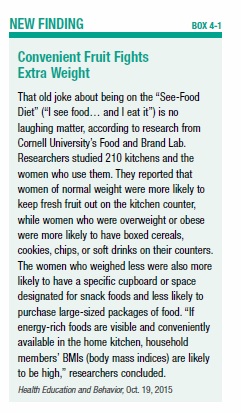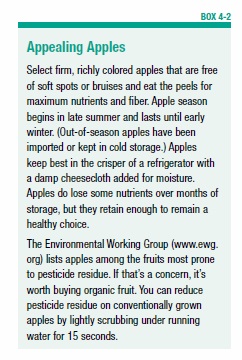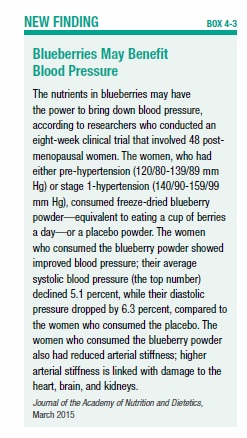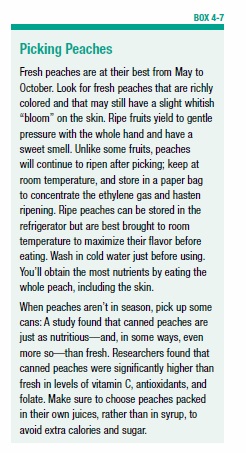4. Choose Richly Colored Fruits
Eat a “Rainbow” for Maximum Nutrition
Much of what we said in the previous chapter about
vegetables also applies to fruits, including the importance of eating a “rainbow” to get a variety of beneficial phytonutrients. According to the USDA’s MyPlate, women over age 50 should get one and a half cups of fruits daily, and men over 50 should aim for two cups. People who are physically active may need even more. In general, one cup of fruit, a half-cup of dried fruit, or an 8-ounce glass of 100-percent fruit juice counts as “one cup” of fruit; one small apple, a large orange or peach, a medium pear, or one large banana also equal “one cup.” In Tufts’ MyPlate for Older Adults, fruits play a prominent part.
Tufts experts provide one note of caution about fruit juice: Although 100-percent fruit juice can be part of a healthful diet, it lacks dietary fiber and, when consumed in excess, it can contribute extra calories. One cup of orange juice, for example, contains just 0.5 grams of fiber, while a cup of orange slices delivers 4.3 grams of dietary fiber, and the orange slices contain only about two-thirds the calories of the juice. And, check the ingredients list before buying: Often, consumers get fooled by “fruit drinks” that contain little actual juice and lots of added sugar, making them similar to soft drinks in terms of nutrition (very little) and calories (very high).
Why Fruits Are Good for You
What makes fruit such an important part of your diet as you age? Start with what fruits don’t contain much or any of: saturated fat, dietary cholesterol, sodium, and calories. On the other hand, fruits are sources of many essential nutrients that you may not be getting enough of, especially as you get older. These include potassium, dietary fiber, vitamin C, and folate.
Eating a diet rich in fruits may reduce your risk for heart disease and protect against some types of cancers. The fiber in fruits may also help guard against developing type 2 diabetes. Fruits help crowd out less-healthy choices, too, which is why they make smart snacks and desserts (see Box 4-1, “Convenient Fruit Fights Extra Weight”).
In 2014, a study of more than 65,000 adults followed for 7.7 years found a “robust association” between fruit and vegetable consumption and lower mortality rates from all causes, including deaths from cardiovascular disease and cancer. In these findings, more was better: The greatest benefits were seen in people eating seven or more servings of produce daily. Compared to people eating less than one daily serving, those consuming the most fruits and vegetables were 33 percent less likely to die of any cause during the follow-up period. Their risk of death from cardiovascular disease was 31 percent lower, and their risk from cancer was 25 percent less.
Like vegetables, fruits are rich in a variety of phytonutrients, compounds in plants that have been linked with a host of health benefits. Examples of phytonutrients found in fruits include carotenoids in cantaloupe, apricots, and oranges, flavonoids in apples and citrus fruits, and polyphenols in grapes and berries. These phytonutrients have been associated with reducing or preventing inflammation, improving immune function, and inhibiting the growth of cancer cells.
Boosting Fruit Consumption
To increase your intake of healthy fruits, simply make them more available: Keep a bowl of whole fruit on the table or kitchen counter. Pre-cut packages of fruit, such as melon or pineapple chunks, make handy, healthy snacks. Place canned or single-serving fruits front and center in your cupboard or pantry.
Frozen fruit is at least as nutritious as fresh, since it’s picked at the peak of ripeness, and freezing locks in nutrients that otherwise deteriorate over time. If you buy canned fruits, make sure to choose those packed in water or 100-percent juice with no added sugar.
The USDA’s MyPlate offers these tips for including more fruits in your diet from morning to night:
- At breakfast, top your cereal with fruit; add blueberries to pancakes; mix fresh fruit with plain fat-free or low-fat yogurt.
- At lunch, pack fruits protected by peels for safe transport, or individual containers of fruits.
- At dinner, add fresh or dried fruits to salads. Try meat dishes that incorporate fruit, such as chicken with apricots or fish with mango salsa, or add fruit like pineapple or peaches to kabobs.
- For fresh fruit salads, mix apples, bananas, or pears with acidic fruits like oranges or pineapple, or add lemon juice to prevent browning.
- For dessert, have baked apples, pears, or a fruit salad.
- Keep a package of dried fruit in your desk or bag for snacking.
- As a snack, spread peanut butter on apple slices, or top yogurt with berries or slices of kiwi fruit.
- Make a fruit smoothie by blending fat-free or low-fat milk or yogurt with fresh or frozen fruit. Try bananas, peaches, strawberries, or other berries. (Note that, unlike “juicing,” which sacrifices most of the fiber, pureeing fruits in a blender preserves the dietary fiber.)
- Try unsweetened applesauce as a lower-calorie substitute for some of the oil when baking cakes.
In the rest of this chapter, we spotlight the nutritional and health benefits of a variety of fruits. Of course, these are just examples—your supermarket’s produce aisle is packed with other good choices. For the best value and nutrient content, buy whatever fruit is in season.
Spotlight: Apples—Keeping the Doctor Away
Is it true that apples are the healthiest fruit, as the saying, “An apple a day keeps the doctor away,” suggests? Diane L. McKay, PhD, consulting editor on this special health report, says, “This is actually one of the questions I like to pose to our PhD candidates during their qualifying exam.” The answer, she says, is that it’s impossible to pick any single fruit as the “healthiest”—but apples certainly belong on the list of fruits to include regularly in your diet.
Start with apples’ fiber content. A medium apple, with peel, contains 4.4 grams of dietary fiber—a good amount, but it’s the makeup of that fiber that’s especially healthy. “Apples have both soluble fiber (pectin) on the inside and insoluble fiber (cellulose) in the skin,” Dr. McKay explains. “Soluble fiber can help remove cholesterol from your body (like the soluble fiber in oats, barley, and beans), slow down the absorption of glucose, and promote healthy bacteria in the colon. The insoluble fiber helps move things along to maintain a healthy gastrointestinal tract, which aids in preventing constipation, hemorrhoids, and diverticular disease.” Note that peeling an apple means throwing away more than half the fiber.
Both types of fiber can help keep you feeling full for longer periods of time, which can help keep your calorie intake lower and promote weight loss. In fact, one study showed that people who ate an apple 15 minutes before mealtime consumed a net fewer 60 calories at the meal, including the calories in the apple, than people who didn’t have an apple before the meal.
Apples are rich in phtyonutrients, which are located primarily in the peels. These include polyphenols such as quercetin, kaempferol, myricetin, epicatechin, and chlorogenic acid (the same polyphenol that gives coffee much of its health benefits). In red apples, the color comes from polyphenols called anthocyanins.
Apple polyphenols can help with blood sugar, because they inhibit enzymes that break complex carbohydrates down into simple sugars. They have also been shown to lessen absorption of glucose from the digestive tract.
Both the soluble fiber and polyphenols in apples may have cardiovascular benefits, helping to improve cholesterol levels and reduce oxidation of fats in the bloodstream. Quercetin has anti-inflammatory effects, and apple consumption has been linked to lower levels of C-reactive protein (CRP), a marker of inflammation tied to heart disease. One study found that women who ate more than 71 grams of apples daily (about half a medium apple) were at 43 percent lower risk of coronary mortality, while men saw a smaller benefit from 54 grams or more daily.
Apples are among a handful of fruits with a specific anti-cancer connection. Apples have been linked to a lower risk of lung cancer, and they also seem to have a protective effect against asthma. And, studies in humans and animals have suggested that apples may reduce the risk of other cancers, including colorectal, larynx, breast, and ovarian.
Apples may also be good for your brain. Tests in mice found a significant improvement in cognitive performance after feeding the equivalent of about 20 ounces of apple juice in humans. In addition to combating oxidative stress, apple compounds may help prevent the decline of the neurotransmitter acetylcholine that occurs with aging.
For tips on choosing and storing apples, see Box 4-2, “Appealing Apples.”
Spotlight: Blueberries—Good for Your Blood Pressure and Brain
Recent research has linked blueberry consumption to better blood pressure (see Box 4-3, “Blueberries May Benefit Blood Pressure”), and Tufts scientists continue to explore how blueberries protect the brain. Other clinical trials are testing blueberries’ possible benefits for vision, gout protection, arterial function, blood sugar, and more.
Blueberries are rich in polyphenols called anthocyanins, which give them their distinctive color. They are also a good source of vitamin C, manganese, and dietary fiber.
Research has suggested that blueberries may have a positive effect on cardiovascular health by improving cholesterol levels.
Because the anthocyanins in blueberries can cross the blood-brain barrier, they may decrease vulnerability to the oxidative stress that occurs with aging, reduce inflammation, and increase signaling between neurons. According to Barbara Shukitt-Hale, PhD, of Tufts’ HNRCA Neuroscience and Aging Laboratory, “A growing body of preclinical and clinical research has identified neurological benefits associated with the consumption of berry fruits. In addition to their now well-known antioxidant effects, dietary supplementation with berry fruits also has direct effects on the brain.”
Among 16,000 women over age 70 participating in the Nurses’ Health Study, researchers found that women who consumed two or more half-cup servings of blueberries or strawberries per week experienced slower mental decline. The association was equivalent to up to two-and-a-half years of delayed aging.
Although the evidence for anti-cancer benefits is limited, the American Institute for Cancer Research does include blueberries on its list of cancer-fighting foods. In cell studies, blueberry phytochemicals have been shown to decrease free radical damage to DNA that can lead to cancer, and to inhibit the growth of cancer cells. In animal studies, blueberries decrease esophageal cancer and estrogen-induced mammary cancer and DNA damage.
For tips on choosing and storing blueberries, see Box 4-4, “Buying Blueberries.”
Spotlight: Oranges—Vitamin C and More
Oranges’ best-known nutritional benefit is their rich cache of vitamin C—about 130 percent of the recommended daily value per orange. Vitamin C is vital for the body’s production of collagen, a key connective protein found in bones, teeth, and cartilage. Vitamin C is also an antioxidant that may prevent cell damage by interfering with the production of free radicals.
One orange also provides 12.5 percent of the recommended daily value of dietary fiber—most of which is lost when squeezed into juice form. Oranges have a low glycemic index, meaning they contain “quality” carbohydrates that release their energy slowly.
Oranges also contain a wealth of lesser-known phytonutrients. These include:
- Limonoids, which have been studied for cholesterol-lowering benefits and anticancer properties.
- Polymethoxylated flavones, found in the orange’s peel, which significantly lower unhealthy cholesterol levels in laboratory animals.
- Beta-cryptoxanthin, a carotenoid that helps give oranges their distinctive color, has been associated with a reduced risk of lung cancer.
- Zeaxanthin, which might help reduce your risk of rheumatoid arthritis (RA): Data from a European study showed that people who consumed the most zeaxanthin were 52 percent less likely to develop RA.
For tips on choosing and storing oranges, see Box 4-5, “All About Oranges.”
Spotlight: Strawberries—Protect Your Heart and Brain
Strawberries, the world’s most popular berry variety, are packed with healthy phytonutrients as well as essential vitamins and minerals. Their health benefits are similar to those of blueberries, with which they’re often combined in studies. For example, the Nurses Health Study II followed about 93,600 women, ages 25 to 42, for 18 years, during which the women completed detailed dietary questionnaires at regular intervals. Women who ate the most strawberries and blueberries—three or more combined servings a week—were 34 percent less likely to suffer an early heart attack. The berry eaters were at significantly lower risk than women who consumed a lot of other fruits and vegetables, but not berries. Researchers speculated that the berry benefits derived in part from anthocyanins, a natural phytonutrient that gives strawberries their bright red color.
Previous studies have linked anthocyanins to improved blood vessel function and lower blood pressure. The anthocyanins and other phytonutrients in strawberries may also lower levels of C-reactive protein (CRP), a marker for inflammation that’s associated with cardiovascular risk.
Strawberries may also be “brain food.” In a Tufts study led by Dr. Shukitt-Hale, strawberry extracts improved cognitive and memory function in rats. For two months, 60 laboratory rats were fed a diet of standard feed, feed with blueberry extract equal to that of a daily one-cup portion for humans, or feed with strawberry extract equal to a daily one-pint bowlful. Half the rats in each group were then chemically treated to induce aging. Compared to the rats on standard feed, the supplemented rats performed better in cognitive tests of learning and memory.
One cup of strawberries (about eight berries) contains more vitamin C than a whole medium orange—about 140 percent of the recommended daily value. A cup of strawberries also delivers more than a quarter of your daily manganese, an essential nutrient that must be obtained from your diet. Manganese helps your body process cholesterol, carbohydrates, and protein; it’s also believed to be involved in bone formation.
Strawberries are relatively good sources of folate, potassium, and dietary fiber. That fiber—about three grams per cup—helps put strawberries low on the glycemic index, despite their high natural sugar content.
Another phytochemical in strawberries, a polyphenol compound called ellagic acid, may help regulate blood sugar response by blocking the activity of an enzyme that breaks up starches into simple sugars, thereby resulting in a slower, more gradual rise in blood sugar levels. One study also found that strawberries actually reduced the blood sugar spike caused by consuming table sugar. Several studies have linked strawberry intake—at least two or three servings a week—to a reduced risk of type 2 diabetes.
For tips on choosing and storing strawberries, see Box 4-6, “Strawberry Smarts.”
Spotlight: Peaches—Possible Cancer Fighter
Peaches are a good source of vitamins, phytonutrients, and fiber, and they may even help fight cancer. One medium peach contains two grams of fiber—most of it the soluble fiber shown to improve cholesterol levels. Eating a peach gives you more than 10 percent of your recommended daily intake of vitamins A and C. Peaches also contain modest amounts of B vitamins, vitamin E, vitamin K, potassium, and copper, iron, and other minerals. Antioxidant phytonutrients in peaches include lutein and zeaxanthin, both linked to eye health, and beta-cryptoxanthin.
Peaches are just as notable for what they don’t have—lots of calories. A typical, medium-sized peach has only 39 calories. Peaches are made up of more than 85 percent water, make a filling, low-calorie snack. Because they are low on the glycemic index, peaches won’t rapidly raise your blood sugar; instead, they are slowly turned into energy in your body, keeping you going longer.
Although peaches have not been studied for health benefits as extensively as some other fruits, recent research suggests they may have anti-cancer properties. In lab tests conducted at Texas A&M University, polyphenol compounds in peaches (as well as plums) selectively killed breast-cancer cells, leaving healthy cells unharmed. Other researchers found that peach extracts slowed the growth of aggressive breast-cancer cells in mice.
For tips on choosing and storing peaches, see Box 4-7, “Picking Peaches.”
Spotlight: Kiwifruit—Vitamin Powerhouse
The kiwifruit is named for the kiwi, the flightless bird native to New Zealand. Originally grown in China and known as “Chinese gooseberries,” this fruit was transported to New Zealand with missionaries in the early 20th century and was renamed upon introduction to the US in the 1960s. Kiwifruit from New Zealand can be found in the produce section of supermarkets from June through October; fruit from California is available the rest of the year.
The bright green flesh, speckled with tiny black seeds, contains more vitamin C per cup than an orange. Kiwifruit has been studied for its antioxidant and phytonutrient properties, which may protect against respiratory conditions. Kiwifruit also may support cardiovascular health; in one study, volunteers who ate two or three kiwifruit a day for four weeks showed an 18 percent improvement in platelet aggregation response, an indicator of risk for blood clots, and a 15 percent reduction in triglyceride levels.
Consume kiwifruit soon after cutting and add to fruit salads just before serving, as enzymes released by slicing cause it and nearby fruits to soften.
The post 4. Choose Richly Colored Fruits appeared first on University Health News.
Read Original Article: 4. Choose Richly Colored Fruits »
Powered by WPeMatico









